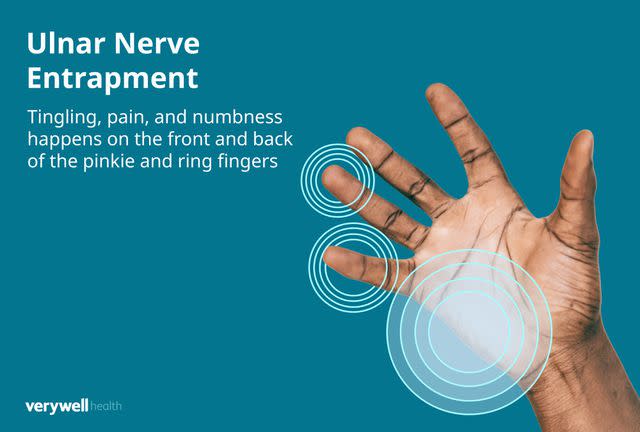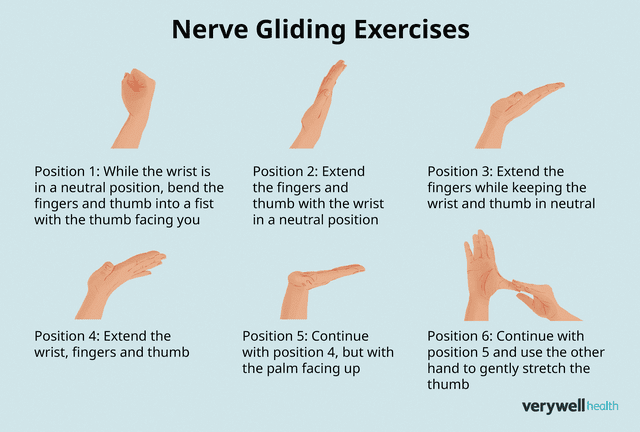Finding Relief for Ulnar Nerve Entrapment
Symptoms, Causes, and Treatment
Medically reviewed by Theresa Marko, PT, DPT, MS
Ulnar nerve entrapment occurs when there is too much pressure on the ulnar nerve. This leads to hand numbness or tingling in the forearm and pinky side of your hand (ulnar neuropathy). It may cause hand or elbow pain or tenderness. In severe cases, it can result in hand muscle weakness or atrophy (wasting away).
The ulnar nerve can be entrapped in the elbow or wrist. Treatment includes modifying your activities to prevent pressure on the elbow or wrist. A healthcare provider may also recommend conservative treatments like splinting or cortisone injection to relieve pressure. Surgery may be needed if these methods do not provide relief.
This article discusses the symptoms, diagnosis, and treatment of ulnar nerve entrapment.

Photo composite by Amelia Manley for Verywell Health; Getty Images
Types of Ulnar Nerve Entrapment
The ulnar nerve is one of the terminal branches (main nerves) of the brachial plexus—a network of nerves that runs through your arms.
The ulnar nerve provides sensation to the inside of your forearm, the pinky side of your hand, your pinky finger, and half of the ring finger. This nerve also supplies muscles that help bend your wrists and fingers, spread your fingers apart, and bring them back together.
The ulnar nerve can be entrapped or compressed inside the elbow or the pinky side of the hand. This results in different syndromes:
Cubital tunnel syndrome is caused by entrapment or compression at the elbow.
Guyon's canal syndrome is cause by ulnar nerve compression in the wrist or hand. It may be called bicycler's neuropathy or handlebar palsy.
Cubital tunnel syndrome is the second most common type of nerve compression (after carpal tunnel syndrome). However, Guyon's canal syndrome is rare.
What Does Ulnar Nerve Entrapment Feel Like?
If you've ever hit your "funny bone"—the point where your ulnar nerve travels close to the skin near the humerus bone on the inside of your elbow—you have an idea what ulnar nerve entrapment symptoms feel like.
Ulnar nerve entrapment causes tingling, pain, and numbness along the path of the ulnar nerve in the forearm and hand, specifically the inside border of your forearm and hand and your fourth and fifth fingers.
When the ulnar nerve is compressed in the cubital tunnel of the elbow, you can experience these symptoms in both your forearm and hand. However, if your nerve is compressed in Guyon's canal, you will only have symptoms in your hand.
The symptoms can come and go. You might have symptoms at night due to the position of your arm while sleeping. The symptoms may resolve on their own if the source of compression is relieved, such as stopping activities that put pressure on the elbow or wrist.
If the ulnar nerve is compressed for extended periods, the muscles it supplies can become weak. You may have poor grip or pinch strength and trouble separating your fingers. It can become hard to open jars, use a keyboard, or play a musical instrument.
In severe cases, these muscles atrophy (waste away). If severe ulnar nerve entrapment is left untreated, a condition that causes the fingers to bend toward the wrist can develop.
What Causes Ulnar Nerve Entrapment?
There are various causes for cubital tunnel syndrome and Guyon's canal syndrome. However, in some cases, it can develop without an apparent reason.
Cubital tunnel syndrome can be caused by the following:
Leaning on the elbow for an extended period
Stretching the nerve by repeatedly bending the elbow (such as in activities that require repetitive pulling or lifting)
Direct trauma to the inside of the elbow
Arthritis
Bone spurs
Swelling in the elbow
Guyon's canal syndrome can occur from:
Repetitive trauma, such as in manual labor, using power tools or a jackhammer
Prolonged pressure on the hand (such as during bicycling, resting the body weight on the handlebar)
Abnormal tendons, muscles, or blood vessels
A fractured (broken) bone in the hand
A cyst or tumor
How Ulnar Nerve Entrapment Is Diagnosed
You can suspect you have ulnar nerve entrapment based on where and when you feel numbness, tingling, or pain. Take notes so you can report this to a healthcare provider, including what you were doing when you experienced symptoms, especially the position of your wrist and elbow and if there was any pressure on those areas.
A healthcare provider will review your symptoms and perform a physical exam. They might use a Tinel's test by gently tapping over the nerve to see if it reproduces your symptoms. But this test along with flexion-compression tests often don't provide enough evidence to diagnose the condition.
A provider may recommend additional testing to confirm a diagnosis of ulnar nerve entrapment, such as:
Nerve conduction studies are the primary tests used to confirm a diagnosis of ulnar nerve entrapment and assess the condition's severity. These tests determine how quickly electrical impulses travel along the nerve and how muscles supplied by the nerve respond to stimulation.
X-ray images can rule out other causes of pain, as well as arthritis or bone spurs that might compress the nerve.
Ultrasound is used to look for physical damage to the nerve.
Magnetic resonance imaging (MRI) scans provide pictures of soft tissue structures (such as muscles and tendons) and the nerve.
Related: Nerve Glides in Physical Therapy
Does Ulnar Nerve Entrapment Go Away?
If you have ulnar nerve entrapment symptoms, don't wait for them to worsen before you seek treatment. Early diagnosis and treatment improve your chances of recovering fully. While medications can help control your symptoms, they aren't the best long-term solution.
Visit an occupational therapist or physical therapist to see if the source of your nerve compression can be identified. Sometimes, it only takes a minor ergonomic adjustment to your workspace.
Treatment for Ulnar Nerve Entrapment
Treatment for ulnar nerve entrapment depends on the severity of the condition. If you haven't yet developed significant muscle wasting, conservative, nonsurgical treatment is usually recommended. This successfully improves symptoms in most cases.
Conservative treatment includes measures you can take at home and work. It consists of:
Nonsteroidal anti-inflammatory drugs (NSAIDs), such as Advil or Motrin (ibuprofen) or Aleve (naproxen) for pain and to reduce inflammation
Avoiding positions and activities that increase pressure on the nerve (such as on the ulnar nerve region or the wrist) or have prolonged elbow flexion (this can include typing with bent elbows, resting your elbows on the arms of a chair, driving while resting your arm on the open window), or triceps-focused strengthening exercises
Splinting at night to prevent full bending of the elbow (to decrease pressure on the nerve): A homemade night splint can be made by wrapping a towel around your straight elbow. Or, you could wear an elbow pad backward.
Nerve gliding exercises: These exercises are aimed at helping the ulnar nerve slide through its tunnel at the elbow and its canal at the wrist. While research has not proven their benefit, they may be recommended to perform at home or as part of physical therapy.
One ulnar nerve gliding exercise is to extend your arm straight in front of you with your palm up. Curl your wrist and fingers toward your upper body. Next, extend your open hand away from you, so the palm is up and wrist bent down. Then, bend your elbow keeping the hand in that position.

Illustration by Julie Bang for Verywell Health
Occupational and physical therapists who treat upper extremity injuries often treat ulnar nerve entrapment conditions. Some of these therapists are specialists called certified hand therapists (CHTs).
Interventions used by these therapists can include:
Custom splinting
Strengthening exercises
Modalities (such as ultrasound and electrical stimulation)
Education on ergonomics and activities that could be aggravating symptoms
Instrument-assisted soft tissue mobilization (IASTM)
Cupping
Surgery
In some cases, nerve decompression surgery is required to relieve pressure on the ulnar nerve. If you have significant weakness or have signs of muscle damage or wasting, a healthcare provider may recommend surgery.
Procedures that may be recommended include:
Cubital tunnel release: This surgery opens the roof of the cubital tunnel to decrease pressure on the nerve. The tissue heals and allows more space for the nerve.
Ulnar nerve anterior transposition: This surgery moves the nerve so it doesn't get caught on the bone when you stretch your elbow.
Medial epicondylectomy: This removes some of the elbow bone to help prevent the nerve from getting stretched when you bend your elbow.
Removal of cysts, scar tissue, or growths: If ulnar nerve compression is due to these issues, they can be surgically removed.
Prognosis for Ulnar Nerve Entrapment
Conservative treatment improves the symptoms of ulnar nerve compression at the elbow in 9 out of 10 people. Early diagnosis and treatment of ulnar nerve entrapment leads to better prognosis for recovery. Long-term nerve compression can lead to permanent loss of sensation and muscle use.
Symptoms may decrease after surgery. However, it can take months to a year for the nerve to recover its normal sensation after surgery. You may benefit from a rehabilitation program and home exercises.
Summary
Ulnar nerve entrapment occurs when the nerve is compressed in the elbow or the hand and wrist. It can cause pain, tingling, and numbness along the inside of the forearm, pinky side of the hand, pinky finger, and half of the ring finger. Nerve entrapment is typically diagnosed with a physical exam and nerve conduction studies.
Treatment includes anti-inflammatory medications, splinting, nerve gliding exercises, and avoiding activities that increase nerve pressure. Occupational or physical therapy can also be beneficial. In severe cases, surgery might be required.
Read the original article on Verywell Health.

